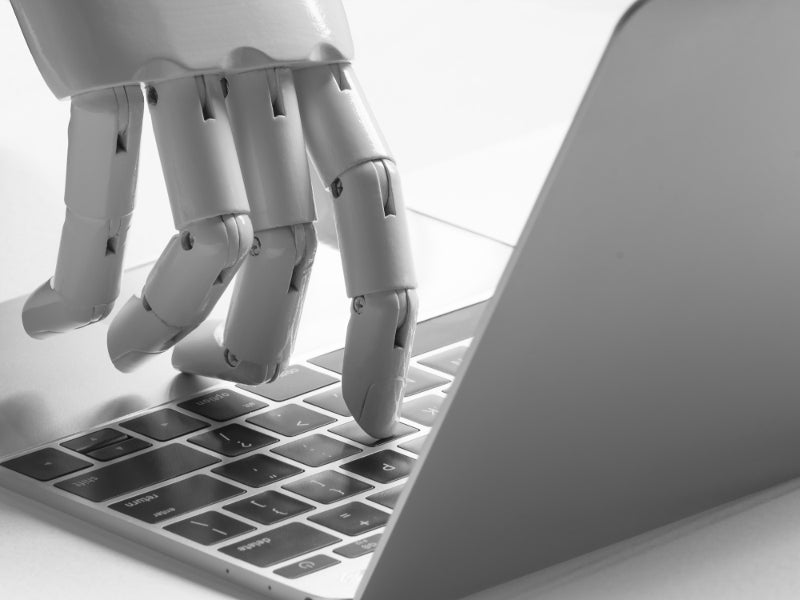
Verdict lists ten of the most popular tweets on artificial intelligence (AI) in November 2019, based on data from GlobalData’s Influencer Platform.
The top tweets were chosen from influencers as tracked by GlobalData’s Influencer Platform, which is based on a scientific process that works on pre-defined parameters. Influencers are selected after a deep analysis of the influencer’s relevance, network strength, engagement, and leading discussions on new and emerging trends.
Most popular tweets in AI in November 2019: the top ten
1. Vala Afshar’s tweet about the difficulty faced by technology leaders in explaining AI and blockchain
Vala Afshar, Chief Digital Evangelist at Salesforce, shared a video of an interview of Bill Gates at a talk show hosted by David Letterman in 1995. Bill Gates tries to explain the internet to Letterman in the video.
Vala compares the video with the current difficulties faced by technology pioneers in describing AI and blockchain. Many industry experts also face ridicule while describing the technologies, adds Vala.
In 1995, only two years after the birth of the worldwide web, @BillGates tried to explain the ‘Internet’ to @Letterman
Technology pioneers today face the same difficulty and ridicule as they attempt to describe artificial intelligence and blockchain pic.twitter.com/HvRoPF6V1L
How well do you really know your competitors?
Access the most comprehensive Company Profiles on the market, powered by GlobalData. Save hours of research. Gain competitive edge.
 Company Profile – free sample
Company Profile – free sampleThank you!
Your download email will arrive shortly
Not ready to buy yet? Download a free sample
We are confident about the unique quality of our Company Profiles. However, we want you to make the most beneficial decision for your business, so we offer a free sample that you can download by submitting the below form
By GlobalData— Vala Afshar (@ValaAfshar) November 19, 2019
Username: Vala Afshar
Twitter handle: @ValaAfshar
Retweets: 467
Likes: 969
2. Mike Quindazzi’s tweet about spatial computing
Mike Quindazzi, Managing director at PricewaterhouseCoopers, shared a video on how spatial computing was being used to create real-time telepresence. The technology uses a volumetrically captured Avatar to represent a person in real-time.
Developed by Mimesys, a company specialising in spatial co-presence technologies, the technology enables real-time collaboration and communication. Mimesys has also developed co-presence technologies for companies such as BNP Paribas, a banking group based in France, and Orange, a telecommunications corporation also based in France.
#SpatialComputing powering real-time telepresence with a volumetrically captured #Avatar >>> @magicleap and https://t.co/H7gcKFa8XE via @MikeQuindazzi >>> #AI #AR #VR #3D #Hologram #UX #UI #IoT #WearableTech pic.twitter.com/mkhrcAhvQ2
— Mike Quindazzi ✨ (@MikeQuindazzi) November 12, 2019
Username: Mike Quindazzi
Twitter handle: @MikeQuindazzi
Retweets: 277
Likes: 357
3. Evan Kirstel’s tweet about AI-powered health pods
Evan Kirstel, Chief Digital Evangelist at eViRa Health, shared a video of AI-powered health pods that are making wellness checks more accessible. Developed by Bodyo, a health technology company based in France, the pods measure a person’s vitals such as height, weight, blood pressure, body glucose, body composition, and metabolism.
Users can login to the pod using biometric scanning and facial recognition technology, following which all the body statistics are measured. The Bodyo app combines this information to enable users to develop a plan to improve their health.
These #AI powered health pods are making wellness checks more accessible! #healthtech #eHealth #digitalhealth #Robotics #IoT #Industry40 #xMed #Artificialintelligence pic.twitter.com/NkmB8mMpSl
— Evan Kirstel #RemoteWork (@EvanKirstel) November 7, 2019
Username: Evan Kirstel
Twitter handle: @evankirstel
Retweets: 276
Likes: 414
4. Ronald van Loon’s tweet about robots overtaking humans
Ronald van Loon, Director at Advertisement, shared a video from the World Economic Forum that details how robots will overtake humans in various tasks. The video states that robots will be able to translate languages by 2024, assemble Legos by 2025, and even write high-school essays by 2026.
The video also shares other examples of robots being capable of driving trucks by 2027, working in retail by 2031, and working as a surgeon by 2053. AI is expected to outperform humans in 50% of all tasks in the next 45 years and result in automation of 50% of all jobs in the next 120 years, according to the video.
This is when #Robots will overtake humans.
by @wef#MachineLearning #ML #DeepLearning #DL #4IR #Robots #ArtificialIntelligenceCc: @chboursin @MikeQuindazzi pic.twitter.com/uRN20iUVNG
— Ronald van Loon #CiscoLive (@Ronald_vanLoon) November 25, 2019
Username: Ronald van Loon
Twitter handle: @Ronald_vanLoon
Retweets: 253
Likes: 289
5. Kirk Borne’s tweet on what happens in an internet minute
Kirk Borne, Principal Data Scientist at Booz Allen Hamilton, shared an infographic that describes what happens on the internet in one minute and how much data is processed in a day. The infographic shows that 3.8 million search queries are entered into Google, 41.6 million messages are sent through WhatsApp and Facebook messenger, and 390,030 apps are downloaded from Google Play Store and Apple App Store, among others.
Another infographic shared by Kirk shows how the Internet of Things (IoT) and connected devices are leading to an exponential growth in data. It shows how much data is processed each day including 500 million tweets, 294 billion emails, four petabyte (pb) of data created by Facebook, and 4TB of data produced by connected cars. By 2025, 463 exabyte of data is expected to be created every day, according to the infographic.
A Day in Data and An Internet Minute!#BigData = the fuel #MachineLearning = the engine #AI = the actionable intelligence #DataScience = the process pic.twitter.com/DgA6ahdlFQ
— Kirk Borne (@KirkDBorne) November 10, 2019
Username: Kirk Borne
Twitter handle: @KirkDBorne
Retweets: 241
Likes: 388
6. Giuliano Liguori’s tweet on self-transforming robot blocks
Giuliano Liguori, Chief Information Officer at CTP, a public transport service company, shared a video of self-transforming robot blocks that can jump, skip, flip, and identify each other. The blocks were developed by the computer science and artificial intelligence laboratory of the Massachusetts Institute of Technology (MIT) under the M-Blocks Modular Robotics project.
The aim of the project is to develop a group of robots that can connect with each other and change their configuration in order to create new structures or robots. The blocks use pulses of angular momentum and magnetic hinges to achieve movement and communicate using a barcode-like system.
Self transforming #Robot blocks jump, spin, flip, and identify each other. {#video} Via @ingliguori #Robotics #ArtificialIntelligence #AI #ML #MachineLearning @jblefevre60 @antgrasso @enricomolinari @AkwyZ @psb_dc @AghiathChbib @Harry_Robots @FrRonconi @Julez_Norton @mvollmer1 pic.twitter.com/MyqCc9hhzB
— Giuliano Liguori (@ingliguori) November 20, 2019
Username: Giuliano Liguori
Twitter handle: @ingliguori
Retweets: 102
Likes: 147
7. Erik Brynjolfsson’s tweets about an interview with an AI language model
Erik Brynjolfsson, Professor at MIT, shared an article containing an interview conducted with an AI called GPT-2. Developed by Openai, an AI research company, GPT-2 is characterised as an unsupervised language model that is designed to process 40GB of data from the internet.
The AI gave coherent answers to various questions posed during the interview, including questions such as what the future of AI is, to which it replied that the technology should be used as a utility and necessary effort should be put into developing it rather than being afraid of the damage it can cause.
Here’s an impressive “interview“ with GPT-2 in @TheEconomist. The answers are more coherent than those of many humans.#AI #NLP #MachineLearning #2MA
Ht: @ilyasut
Cc: @JeffDean @ylecun @AndrewYNg @GaryMarcus @jackclarkSF @OpenAI @indexingai @mit_ide https://t.co/6fU2CUWxQF— Erik Brynjolfsson (@erikbryn) November 25, 2019
Username: Erik Brynjolfsson
Twitter handle: @erikbryn
Retweets: 84
Likes: 125
8. Tamara McCleary’s tweet on next-generation applications of AI
Tamara McCleary shared an article detailing the next-generation applications of AI and machine learning including credit card fraud detection, virtual stylist, and data management. AI can help in detecting a fraudulent credit card transaction before it is completed thereby reducing the number of transactions made by fraudulent card users.
AI can also help in serving as a virtual stylist by recognising customers’ face and clothing to suggest recommendations. Further, the technology can help in smart data management by identifying duplicate data entries.
The Next-Generation Applications Of Artificial Intelligence And #MachineLearning https://t.co/s8k9RytlUF #AI pic.twitter.com/ukJ09RmA2k
— Tamara McCleary (@TamaraMcCleary) November 29, 2019
Username: Tamara McCleary
Twitter handle: @TamaraMcCleary
Retweets: 82
Likes: 93
9. Spiros Margaris’ tweet on using AI to transform a photo into a dance video
Spiros Margaris, a venture capitalist, shared a video that describes how a research team at NVIDIA Corporation, a technology company, has developed an AI that can combine an existing video and a single image to make the person in the image to imitate the movements in the video.
The technology uses the video-to-video synthesis method and an input video such as human poses to create a video from an image. The technology, currently in the initial stages of development, is expected to be useful in movies and games.
How @Nvidia's new #AI can make anyone
move like Jagger with just a single #photo https://t.co/GBYVpiUm4T #fintech #ArtificialIntelligence #MachineLearning #DeepLearning @IndianIdle @thenextweb@pierrepinna @Paula_Piccard @jblefevre60 @Fisher85M@HaroldSinnott pic.twitter.com/RPsZmpppNA
— Spiros Margaris (@SpirosMargaris) November 5, 2019
Username: Spiros Margaris
Twitter handle: @SpirosMargaris
Retweets: 74
Likes: 76
10. Chris Anderson’s tweet about the world’s smaller AI supercomputer, Jetson Xavier™ NX
Chris Anderson, the CEO of 3DR, a robotics company, tweeted about the Jetson Xavier™ NX, which is considered as the world’s smallest and most powerful AI supercomputer. Developed by Nvidia Corporation, a technology company, the supercomputer is the size of a credit card and can perform 21 Tera operations per second.
The supercomputer consumes less than 10W of power and processes data from multiple high-resolution sensors.
This is huge! A Jetson Nano form factor but 20+x the performance. It will allow @DIYRobocars using AI with full resolution video and multiple deep learning stacks running simultaneously (lane keeping, obstacle avoidance, goal identification, etc). Works with Nano dev board https://t.co/l2oUmCza7c
— Chris Anderson (@chr1sa) November 6, 2019
Username: Chris Anderson
Twitter handle: @chr1sa
Retweets: 62
Likes: 228







